Table of Contents
- Introduction
- Editor’s Choice
- Robotic Process Automation Statistics By Market Size
- Global Robotic Process Automation Software Revenue Statistics
- RPA Software End-User Spending
- Top Companies RPA Funding
- Robotic Process Automation Statistics By Industries Adopting
- Benefits of RPA Implementation
- Challenges in Robotic Process Automation Implementation Statistics
- Recent Developments
- Conclusion
- FAQs
Introduction
Robotic Process Automation Statistics: RPA is a transformative technology that leverages robot software to automate rule-based tasks within digital systems. It operates by identifying repetitive tasks and developing software bots to execute them.
Seamlessly integrating these bots with existing software applications. RPA offers numerous benefits, including cost efficiency, accuracy, scalability, and enhanced productivity.
Its adoption is on the rise across industries, with the global RPA market poised for significant growth. This technology has the potential to revolutionize business operations.
By reducing costs, improving efficiency, and allowing human employees to focus on more strategic activities. Ultimately enhancing overall productivity and competitiveness.
Editor’s Choice
- The global robotic process automation (RPA) market stood at 1.23 billion in 2020. And it is anticipated to reach 12.22 billion by 2029.
- In 2021, the RPA software revenue continued its ascent, surging to 1,888.1 million USD. Showing an impressive growth rate of 19.53%.
- In 2021, the RPA software revenue continued its ascent, surging to 1,888.1 million USD. Showing an impressive growth rate of 19.53%.
- Robotic Process Automation (RPA) adoption varies significantly across industries, with manufacturing leading the way at 35%.
- A survey found that 53% have already started with RPA, and 19% plan to do so within 2 years.
- Impressively, 78% of existing RPA users expect increased investment in the next 3 years.
- Many organizations tend to underestimate the time and cost required for RPA implementation. With 63% finding the implementation time longer than expected and 37% experiencing higher-than-anticipated implementation costs.
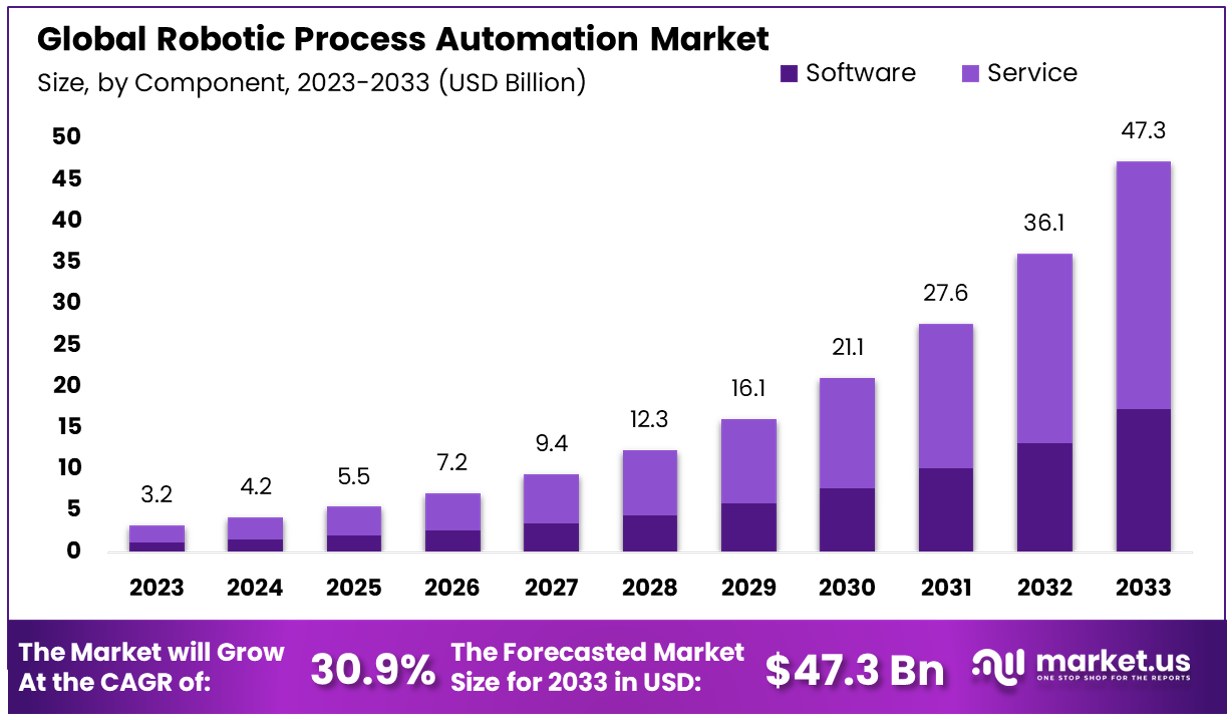
Robotic Process Automation Statistics By Market Size
- The global Robotic Process Automation (RPA) market has witnessed remarkable growth. In recent years, as indicated by its market size in USD billions.
- In 2020, the market stood at 1.23 billion, and this figure surged to 2.07 billion in 2021.
- The momentum continued into 2022, with the market reaching 3.17 billion.
- Looking ahead, the RPA market is projected to expand significantly. With estimations of 4.41 billion in 2023, 5.7 billion in 2024, and 7.01 billion in 2025.
- The growth trajectory continues into the late 2020s. With forecasts of 8.33 billion in 2026, 9.66 billion in 2027, and 10.96 billion in 2028.
- By 2029, the market is anticipated to reach 12.22 billion. It is expected to surpass 13.39 billion by the year 2030.
- This steady and substantial growth underscores the increasing adoption of RPA across industries as organizations recognize. The value of automation in optimizing processes and enhancing operational efficiency.
(Source: Statista)
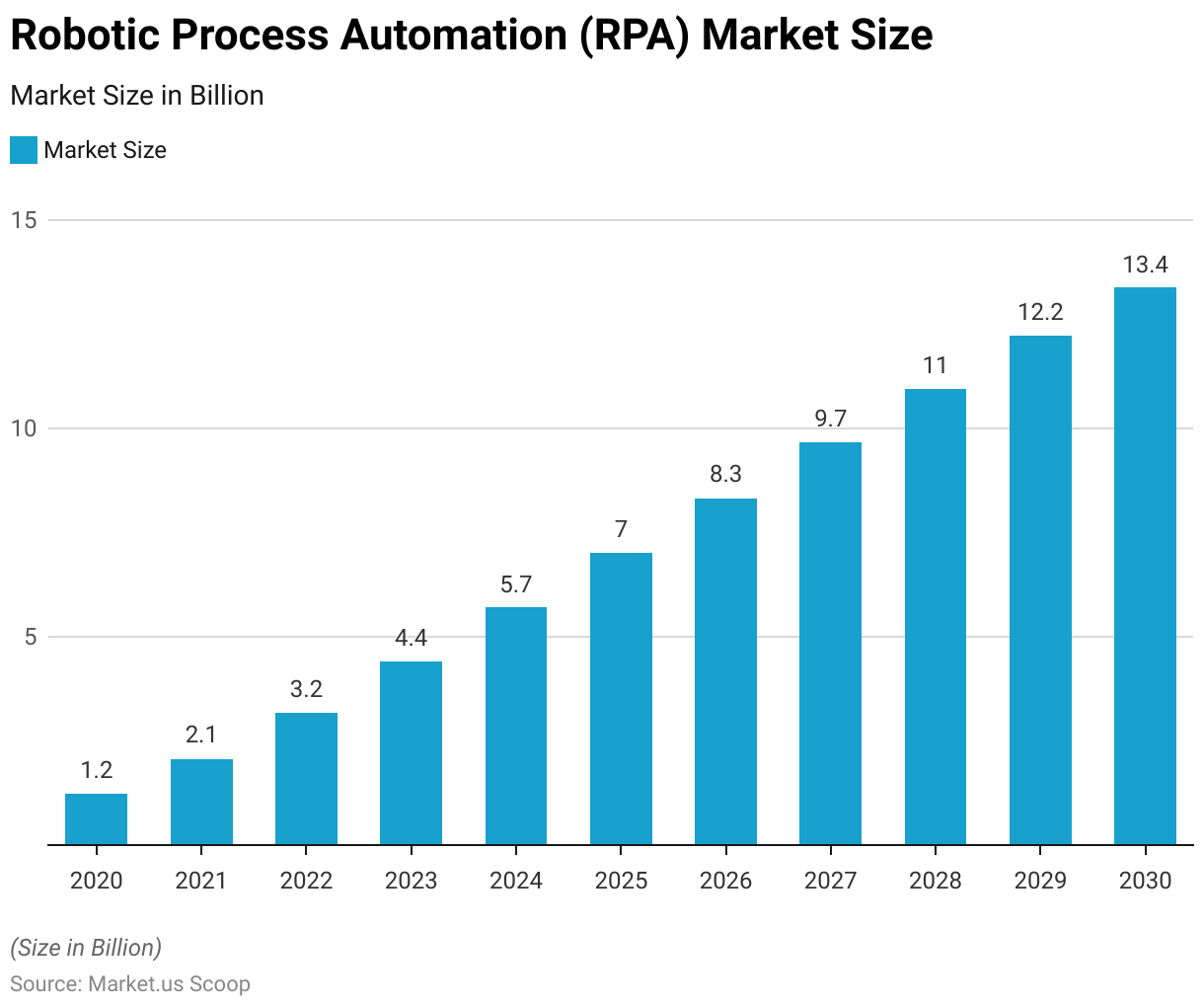
Global Robotic Process Automation Software Revenue Statistics
- In the realm of Robotic Process Automation (RPA), software revenue has demonstrated a remarkable growth trajectory over recent years.
- In 2019, the revenue reached 1,411.1 million USD, marking a substantial growth of 62.93%. This momentum persisted into 2020, with RPA software revenue increasing to 1,579.5 million USD, reflecting a growth rate of 11.94%.
- The following year, in 2021, the RPA software revenue continued its ascent. Surging to 1,888.1 million USD, showcasing an impressive growth rate of 19.53%.
- These figures underscore the escalating adoption and significance of RPA in streamlining processes and enhancing efficiency across various industries.
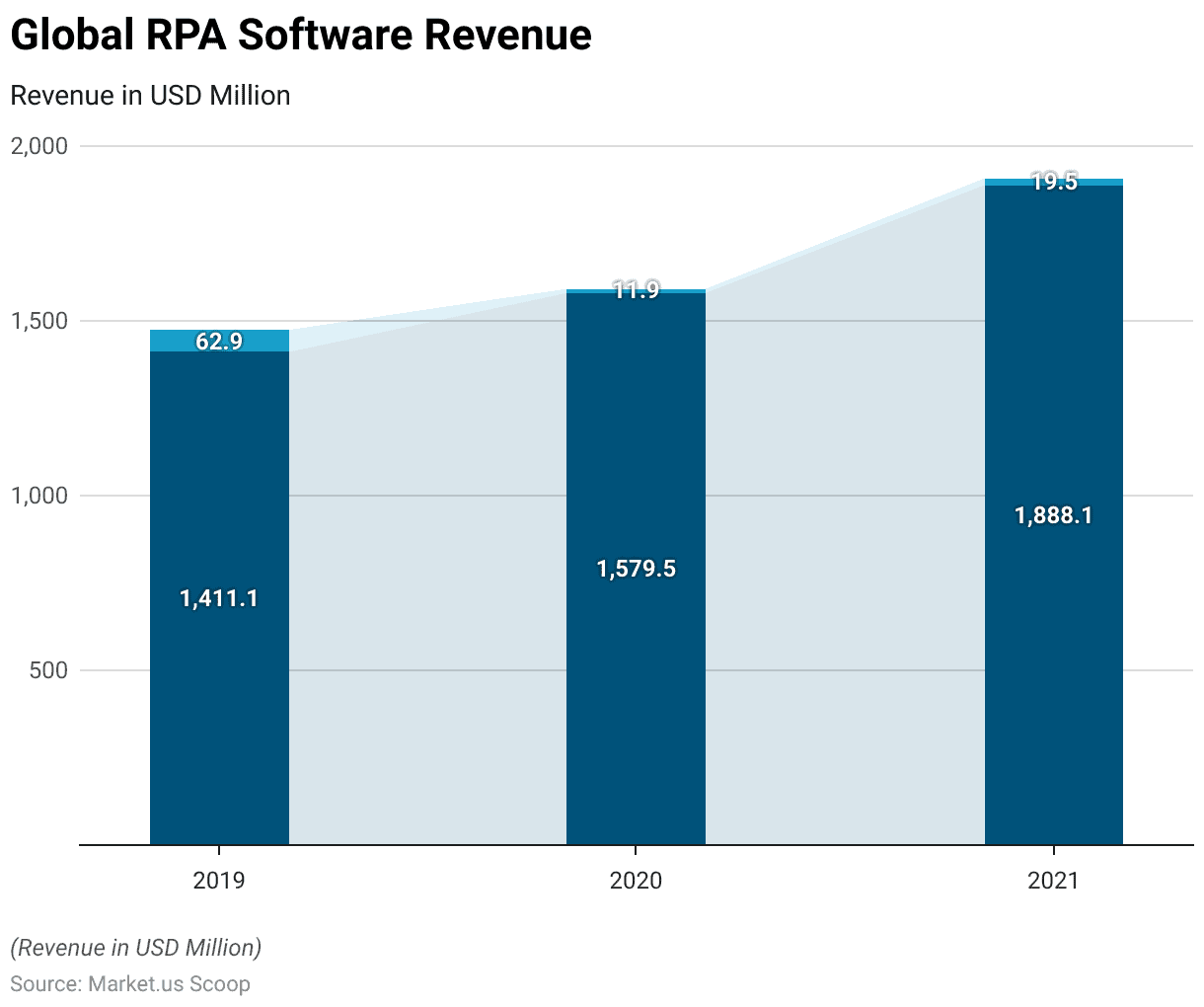
RPA Software End-User Spending
- In terms of end-user spending, there has been a remarkable upward trend over the past few years.
- In 2021, end-user spending reached 2,389 million USD, experiencing a robust growth rate of 30.9%.
- This positive momentum continued into the following year, 2022. With end-user spending increased to 2,854 million USD, reflecting a notable growth rate of 19.5%.
- The trend persisted into 2023, where end-user spending climbed to 3,352 million USD, marking another substantial growth of 17.5%.
- These figures underscore the increasing investment and expenditure by end-users. Highlighting the growing significance and adoption of the subject matter over this period.
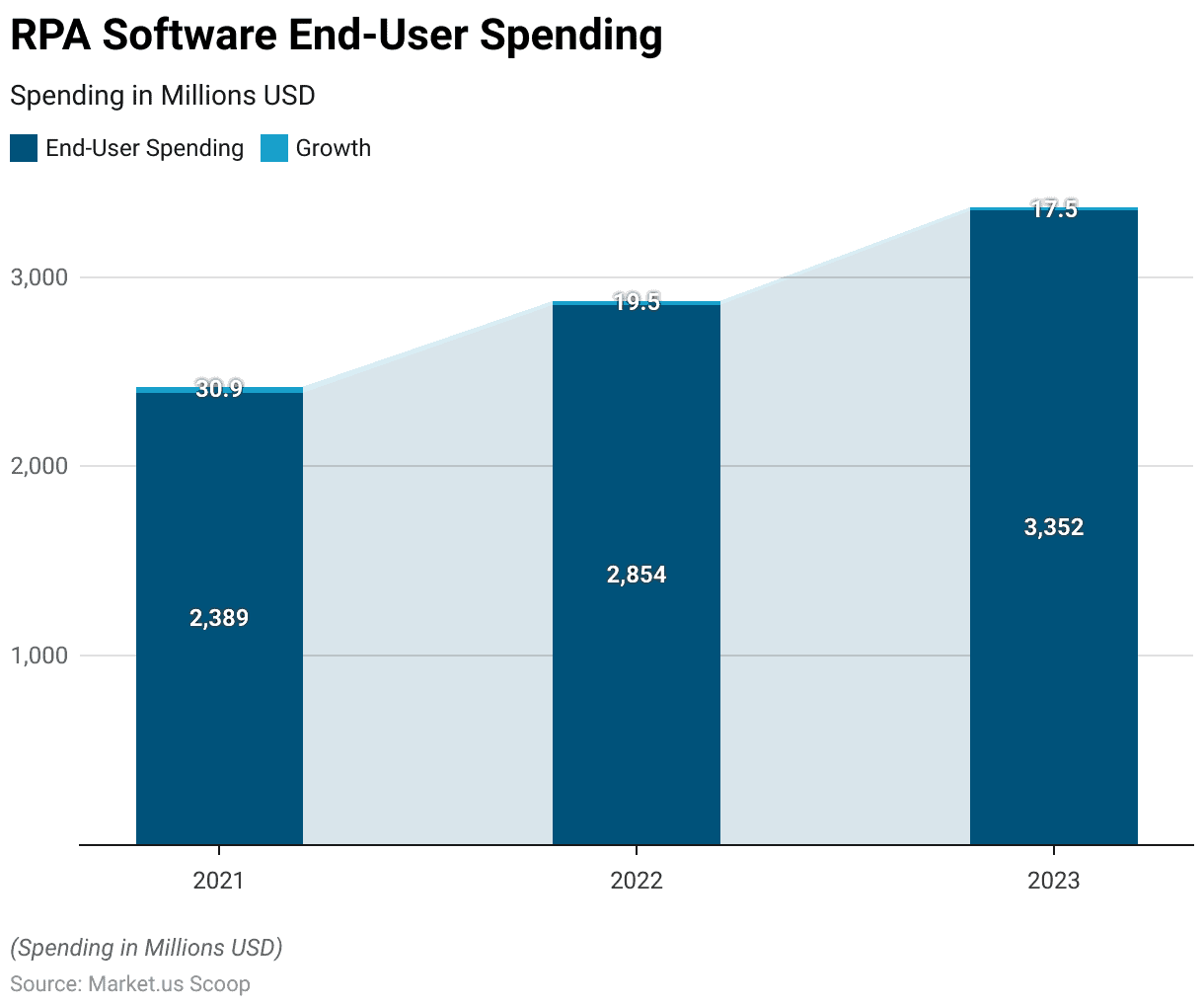
Top Companies RPA Funding
- In the realm of Robotic Process Automation (RPA) companies, notable funding rounds have played a significant role in their growth.
- UiPath secured substantial total funding of $1.2 billion across six rounds, while automation Anywhere closely followed with $840 million over four funding rounds.
- Blue Prism Group accumulated $182 million through five rounds, and Workfusion secured $180 million through six funding rounds.
- These figures underline the substantial investments and financial backing that these RPA companies have received, reflecting the growing importance and adoption of RPA in various industries.
(Source: Crunchbase)
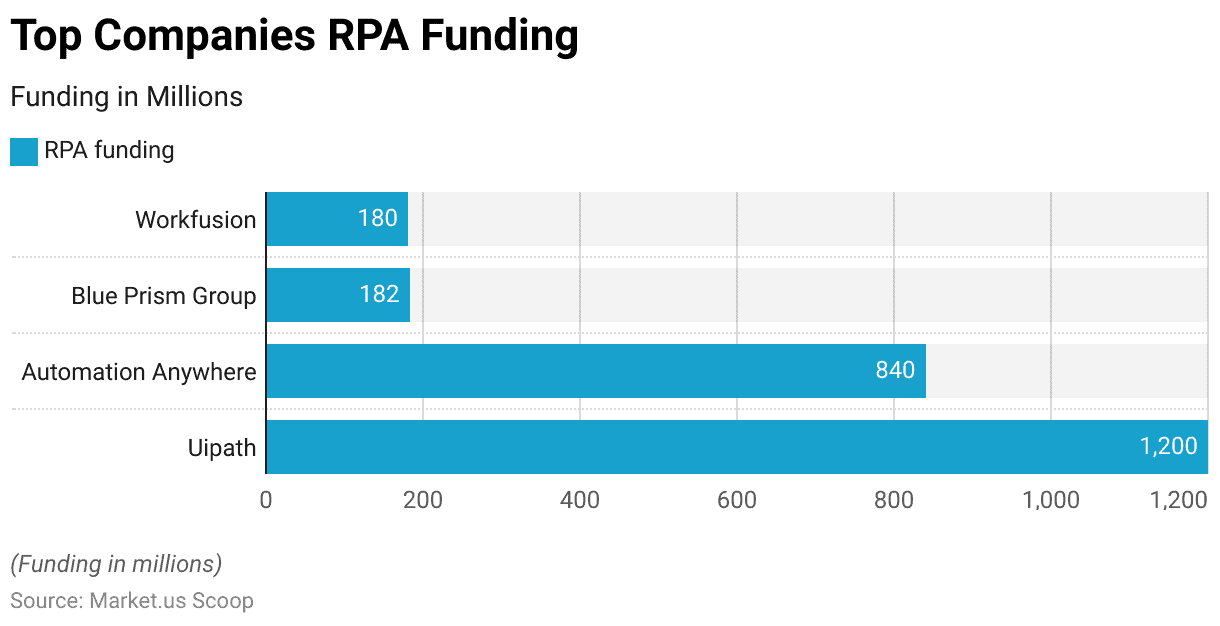
Robotic Process Automation Statistics By Industries Adopting
- Robotic Process Automation (RPA) adoption varies significantly across industries, with manufacturing leading the way at 35%.
- The technology sector closely follows, with a substantial adoption rate of 31%.
- In the healthcare industry, RPA adoption stands at 10%, indicating a growing recognition of its potential to streamline administrative and operational processes.
- Retail and Consumer Packaged Goods (CPG), as well as the finance sector, both report an 8% adoption rate, reflecting a notable presence of automation in these domains.
- The public sector, including government agencies, demonstrates a 5% adoption rate, while the education sector trails behind with 3%.
- These statistics highlight the diverse landscape of RPA implementation, with some industries being early adopters, capitalizing on the benefits of automation to enhance efficiency and productivity, while others are gradually exploring its potential for transformation.
(Source: Acceleration Economy)
Take advantage of our unbeatable offer - buy now!

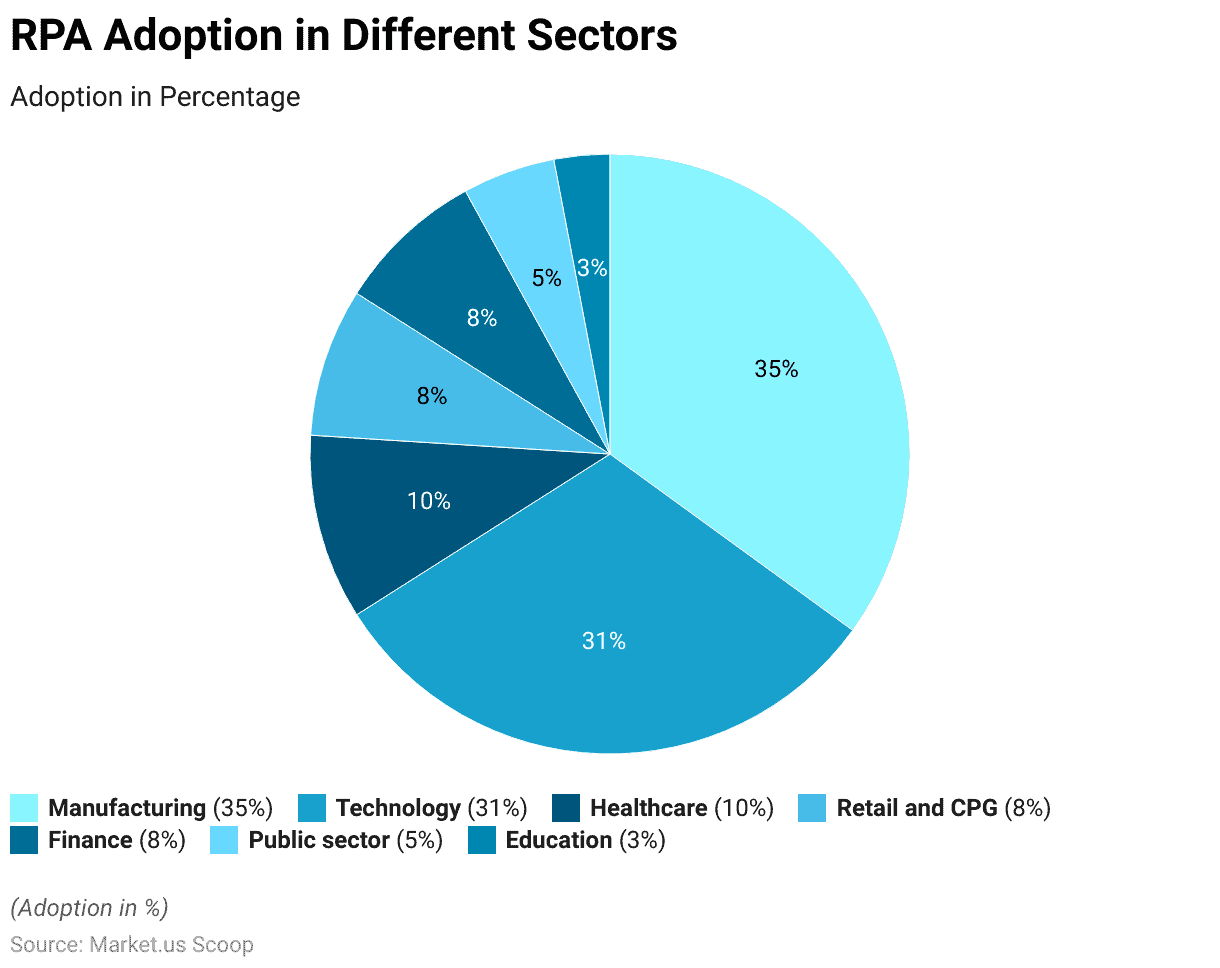
Robotic Process Automation Statisticsby RPA in Healthcare
- Through the incorporation of robotic process automation (RPA) in healthcare claims management, Care1st Health Plan Arizona significantly shortened the time required to process individual claims from 20 seconds to a mere 3 seconds.
- Another instance of RPA’s impact on healthcare comes from Avera Health, a regional health system operating across five states.
- Avera effectively deployed RPA bots to verify user account statuses and promptly inform Avera managers about pending or incomplete claims. This strategic move resulted in substantial savings of $260,000 in employee-related expenses for Avera Health.
- The application of RPA in the realm of medical insurance holds the potential for a substantial 30% reduction in claims processing expenses for companies that automate approximately 60-70% of tasks linked to claims administration.
- Baylor Scott & White Health (BSWH), a healthcare network with 52 hospitals in the USA, implemented an RPA and AI-driven system for evaluating medical claims.
- Normally, in healthcare, it takes staff about five to seven minutes to estimate patient costs before treatment.
- However, through the use of smart bots, BSWH now generates 70% of these cost estimates automatically, eliminating the need for human intervention.
- Pre-pandemic, about 88% of appointments were manually arranged, resulting in delays of up to two months between referrals and actual visits.
- This incurred a considerable annual expense of $150 billion for healthcare providers because of missed appointments.
- Integrating RPA medical bots into appointment scheduling and patient engagement software enables hospitals to remove manual data input and lower no-show rates, which can fluctuate between 5% and 39% depending on the healthcare field.
(Source: TechTarget, McKinsey, Forbes, Robotics and Automation News, Healthcare Finance News, Itrex Group and Solution Reach)
Robotic Process Automation Statistics by RPA in Manufacturing
- A survey reveals that 43% of manufacturers currently employ RPA, and an additional 43% intend to launch new RPA projects. RPA is becoming more intelligent through integration with technologies like Artificial Intelligence and Machine Learning.
- The World Economic Forum predicts that by 2022, 42% of manufacturing tasks will be automated, resulting in significant cost reductions, ranging from 4% to 12% in procurement expenses. This could mean substantial annual savings for certain companies.
- For example, a life sciences company can save about $19 million (equivalent to 5%) in direct material costs by using RPA-driven parts optimization, which includes improving pricing consistency, centralizing procurement, and enhancing design standards.
- Similarly, industrial product manufacturers can reduce spending by more than $30 million across 18 categories and cut $530 million in parts expenses through RPA-driven parts optimization.
- By digitizing 600,000 unique parts and analyzing data from 100,000 drawings and data sheets, nearly 30% of parts can be identified as duplicates for elimination in the short term.
- Additionally, suggesting preferred parts for retrieval and reuse has the potential to reduce the company’s overall parts inventory by 47% in the long run.
(Source: Impactmybiz, World Economic Forum, Deloitte)
Robotic Process Automation Statistics by RPA in Finance
- Approximately 80% of finance leaders have either already put RPA into action or have intentions to put it into action. However, embracing new digital technologies and transitioning to the cloud continues to pose challenges.
- Merely 37% of finance departments have a well-defined strategy for investing in digital technology over the next two to three years.
- Furthermore, 64% of CFOs believe that autonomous finance can be achieved within the next six years.
- A robotic FTE can work for at least 20 hours a day.
- It can easily work for seven days per week and 52 weeks per year.
RPA in the Telecom Industry
- In a survey conducted in 2020, it was found that telecom service providers are witnessing a growing preference for unassisted customer service portals.
- About 69% of telecom customers now try to resolve their technical problems on their own before seeking assistance from the service provider.
- Moreover, customers who make an unsuccessful attempt to fix their issues before requesting a technician’s help tend to rate their satisfaction 16 points lower on a 1000-point scale.
- RPA bots offer a self-service portal that’s available around the clock for customers. These bots can gather information about the customer’s inquiry, enhancing the overall customer experience.
- As per a Nokia study, network traffic experiences an annual growth rate of 30-45%, which puts added pressure on service providers to guarantee the adequacy of their infrastructure. The use of RPA bots can substantially decrease the manual effort involved in monitoring networks.
- Deloitte asserts that telecom firms are prime targets for cybersecurity threats due to their oversight of critical national and international infrastructure and their possession of substantial customer data such as phone numbers and addresses.
- Given the increasing expenses associated with cyberattacks and data breaches, which can reach up to $4 million per breach, it is crucial to minimize these risks to prevent damage to a brand’s reputation and legal consequences. RPA bots offer a means for telecom service providers to bolster their defenses against cybersecurity threats.
(Source: ResearchAImultiple.com, Deloitte, Nokia)
RPA in E-commerce
- Approximately 50% of eCommerce companies utilize marketing automation software to attract more shoppers.
- Projections indicate that by 2025, automated systems will handle 95% of customer interactions with retailers, including phone calls and live chat.
- Interestingly, a majority of consumers, 73%, are receptive to AI handling customer service as long as it enhances the quality of service.
- Experian’s findings show that customers receiving automated emails regarding incomplete shopping cart purchases are 2.4 times more likely to complete the purchase.
- The demand for faster deliveries will drive automated warehousing and logistics shipments to reach 620,000 units by 2021.
- Furthermore, automated smart warehouses have a 40% higher likelihood of shipping orders within one day of purchase, leading to reduced labor costs.
(Source: Clickz, Finance Digest, Pega, Experian, Tractica, Robotics Business Review)
Benefits of RPA Implementation
- A survey found that 53% have already started with RPA, and 19% plan to do so within two years.
- Impressively, 78% of existing RPA users expect increased investment in the next three years.
- Furthermore, 61% reported successful cost reductions through RPA. In terms of support, 63% will work with implementation partners, 19% seek help from RPA vendors, and 15% will handle it internally.
- Over 90% of C-level executives using intelligent automation believe their organizations excel at managing change in response to evolving business trends.
- On the financial side, RPA pilot programs anticipate a 9-month payback, though the actual payback for scaled RPA has been 12 months.
- There’s an anticipation that robots could handle a substantial part of current routine tasks, with an average estimate of 20% of human work capacity being taken over by robots.
- Among those who’ve already adopted RPA, they believe robots could contribute as much as 52% of the work capacity, freeing up human workers for more valuable tasks.
(Source: Deloitte Global RPA Survey)
Challenges in Robotic Process Automation Implementation Statistics
- A mere 3% of organizations have successfully expanded their digital workforce.
- Additionally, many organizations tend to underestimate the time and cost required for RPA implementation, with 63% finding the implementation time longer than expected and 37% experiencing higher-than-anticipated implementation costs.
- Interestingly, only 17% of respondents encountered employee resistance when piloting RPA, and this resistance dropped significantly to just 3% among those actively implementing or scaling RPA.
- For the majority of organizations, approximately 63%, the implementation process will involve collaborating with dedicated third-party partners due to a shortage of specialized skills.
- The majority of executives express concern about their organization’s lack of essential skills for automation, with 90% feeling they lack the necessary skills for basic process automation.
- 89% perceive a deficiency in skills for advanced process automation.
- 75% acknowledge a shortfall in skills for intelligent process automation.
- Interestingly, only 20% of surveyed executives have made concrete plans to retrain or upskill their workforce in response to these skill gaps.
(Source: Deloitte Global RPA Survey, IBM)
Recent Developments
Acquisitions and Mergers:
- UiPath acquires Cloud Elements: In early 2023, UiPath acquired Cloud Elements, a leading API integration platform, for $180 million. This acquisition aims to enhance UiPath’s capabilities in integrating RPA with various cloud applications and services.
- Blue Prism merges with SS&C Technologies: In late 2023, Blue Prism merged with SS&C Technologies in a deal valued at $1.3 billion. This merger is expected to expand Blue Prism’s RPA solutions within the financial services sector, leveraging SS&C’s expertise.
New Product Launches:
- Automation Anywhere’s AARI 2.0: Automation Anywhere launched AARI 2.0 in mid-2023, an advanced version of its digital assistant designed to simplify automation for business users by providing a conversational interface and enhanced integration capabilities.
- Microsoft Power Automate Desktop: Microsoft introduced Power Automate Desktop in early 2024, bringing powerful RPA tools to Windows 11 users. This product aims to democratize automation by making it accessible to both technical and non-technical users.
Funding:
- Automation Anywhere raises $300 million: In 2023, Automation Anywhere secured $300 million in a Series F funding round to accelerate its product development and expand its global market reach.
- UiPath secures $750 million: UiPath raised $750 million in early 2024 to enhance its RPA platform, focusing on AI-driven automation and expanding its capabilities in enterprise automation solutions.
Technological Advancements:
- AI-Driven RPA: The integration of AI with RPA is advancing, enabling more intelligent automation solutions. AI-driven RPA can handle unstructured data, learn from interactions, and make decisions, enhancing the scope and efficiency of automation.
- Cloud-Based RPA Solutions: Cloud-based RPA solutions are gaining traction, offering scalability, flexibility, and reduced infrastructure costs. These solutions allow businesses to deploy and manage RPA bots more efficiently.
Market Dynamics:
- Growth in RPA Market: The global RPA market is expected to grow at a CAGR of 27.7% from 2023 to 2028, driven by increasing adoption across various industries such as banking, healthcare, and retail.
- Increased Adoption in SMEs: Small and medium-sized enterprises (SMEs) are increasingly adopting RPA solutions to automate repetitive tasks and improve operational efficiency, with a projected adoption growth of 25% annually.
Regulatory and Strategic Developments:
- Data Privacy Regulations: As RPA solutions handle sensitive data, compliance with data privacy regulations such as GDPR and CCPA is becoming crucial. RPA providers are enhancing their platforms to ensure data security and regulatory compliance.
- Industry Standards for RPA: Industry bodies are working on establishing standards for RPA implementations to ensure best practices, interoperability, and security, fostering a more reliable and scalable RPA ecosystem.
Research and Development:
- Advancements in Cognitive Automation: R&D efforts are focusing on cognitive automation, which combines RPA with AI and machine learning to automate more complex processes that require decision-making and adaptation.
- Development of Low-Code RPA Platforms: Researchers are developing low-code RPA platforms that allow users to create automation workflows with minimal coding, making automation more accessible to non-technical business users.
Conclusion
Robotic Process Automation Statistics – Robotic Process Automation (RPA) has witnessed remarkable growth across industries, reshaping business operations with its widespread adoption and diverse applications.
The technology’s ability to automate a wide range of processes and deliver tangible benefits, such as cost reduction and increased productivity, as well as its emergence in hybrid deployments, have solidified its position in the market.
While major vendors continue to dominate, newer players contribute to innovation. RPA’s impact on the workforce is a topic of concern and opportunity, with job displacement balanced by the creation of new roles.
Industry-specific applications in finance, healthcare, and customer service highlight its versatility, and the integration of artificial intelligence and machine learning signals a promising future for RPA as it evolves to meet evolving business needs.
FAQs
RPA is a technology that uses software robots or bots to automate repetitive, rule-based tasks. It is important because it improves efficiency, reduces errors, and lowers operational costs for businesses.
Industries such as finance, healthcare, manufacturing, and customer service have been at the forefront of RPA adoption due to their potential to optimize various processes within these sectors.
RPA implementation offers benefits like increased productivity, cost reduction, improved accuracy, enhanced customer service, and faster process execution.
Many organizations are exploring hybrid RPA deployments, combining on-premises and cloud-based solutions to suit their specific needs.
The future of RPA includes the integration of artificial intelligence (AI) and machine learning (ML), making bots smarter and more adaptive. RPA will continue to evolve to meet changing business needs.
Discuss your needs with our analyst
Please share your requirements with more details so our analyst can check if they can solve your problem(s)



